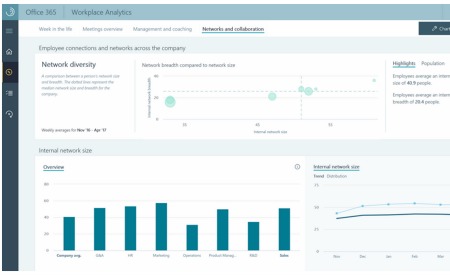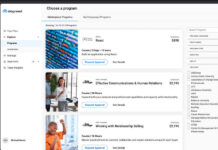
Microsoft has unveiled Workplace Analytics, an add-on to Office 365 Enterprise plans that gathers aggregate metadata from Office 365 users and puts it to work generating information that’s largely about productivity. As an example, it can crunch email and calendar data to calculate how many meetings workers attend each week, how much time they spend with email, how often they work after hours and the number of connections they have both inside and outside the company. The resulting intelligence is presented through Microsoft Graph.
When Microsoft talks about Workplace Analytics’ “metadata,” it’s referring to information such as email senders and recipients, subject lines and timestamps. That data, the company says, can “shine a light on how the organization collaborates and spends time. It turns this digital exhaust—the data that comes naturally from our everyday work—into a set of behavioral metrics that can be used to understand what’s going on in an organization.”
Microsoft’s pitch for Workplace Analytics is all about identifying trends and patterns that can be leveraged to enhance an organization’s performance. To use two of its examples, sales managers could “identify the collaborative patterns of top performers and scale that to the rest of the organization to increase sales” or “analyze data from employee calendars to limit the time spent going from one meeting to another by relocating.” Its own HR group is reportedly using Workplace Analytics to understand the behaviors that drive engagement and identify the characteristics of top-performing managers.
Last year, Microsoft launched MyAnalytics, which allowed individual Office 365 users to track how they spent their time and who they were spending it with. At the time, Microsoft said data would only be visible to individual users, not to their managers. Microsoft says that’s still the case. In an article on the Workplace Analytics launch, TechCrunch cited Office 365 Director Alym Rayani as saying none of the companies involved in the product’s private beta used it to “call out” employees.
“The tool is not designed for business leaders to interrogate individual-level behaviors,” a spokesperson told us in an email. “The primary interface uses anonymized and aggregated data to allow for exploration of behavior patterns at the group level.” Within the tool itself, “Workplace Analytics KPIs are de-identified … Typically, our customers leverage Workplace Analytics to enable strategic business decisions around sales productivity, combating collaboration overload and to empower their people to work more effectively in teams.”
It shouldn’t come as a surprise that Microsoft wants to capitalize on the data that’s naturally generated by people using its tools to go about their work. And because the company has such a wide universe of users, it’s well-positioned to provide this kind of workforce intelligence to a variety of organizations from the enterprise on down. Although MyAnalytics and Workplace Analytics are available only to enterprise customers (Microsoft wouldn’t comment on Workplace Analytics pricing, by the way), we can imagine templated or less-robust versions being offered to smaller companies over time. And, we know more than a few individuals who’d happily spend the $4 per-user monthly fee on MyAnalytics to help themselves work more efficiently.
Image: Microsoft
















